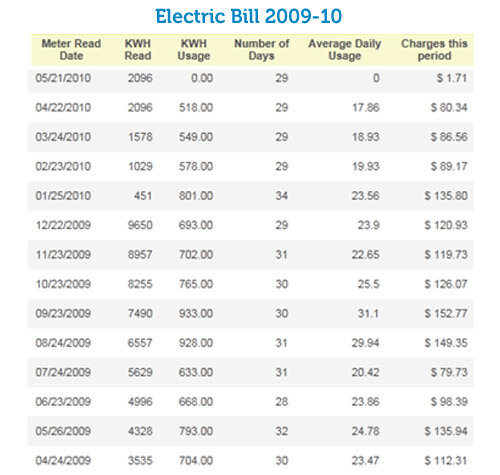Go Solar Success Story: Our Year in the Sun... On Solar Power
This month marks our one year solar power anniversary. Am I still a happy solar camper? You betcha!
Based on my calculations from the last year, we generated 555 kWh more than what we used. That's right -- we generated an extra half a megawatt hour. In the previous year we consumed 8,561 kWh. The year before that, 9,260 and before that, 9,779 (so year over year our consumption was decreasing as we became more energy conscious).
Enough KWH... How much money did I save?
Annual Cycle
2010-11
2009-10
2008-09
2007-08
kWh
-555
8561
9260
9779
Bill
$17.86
$1,374.78
$1,434.10
$1,591.96
Savings
-$1,356.92
-$59.32
-$157.86
We saved $1,357 dollars in the last year on electricity.
Yes, we "paid" less than 20 bucks for electricity for the entire year. ("Paid" because our last bill ended up becoming a credit so we've been working off that credit.) We're now down to -$117, i.e. at 2 bucks or less we might not be paying a bill for a long while.
And guess what? The California Assembly passed a bill which was signed in 2009 (AB920) where we're going to be paid BACK by the Electric company for that extra 555 kWh we generated. Yep, we're going to bill the electric company! We just got a letter this week saying they are trying to figure this out... so we're not running off to Vegas with our extra cash just yet.
Upfront and Ongoing Costs
Upfront cost was $29K. After a $6.5k rebate from SoCal Edison we paid $23K out of pocket. This year we filed for our energy tax credit, which went smooth as silk. A 30% credit on the cost of the panels and installation (after the rebate from SCE).
$29,000 (Upfront Cost) - $6,500 (SCE Rebate) - $7,000 (energy tax credit) = $16,100 end cost
And an important point is we own these panels. They are ours forever. If we move, we can take them with us. Also, since we own them, they are officially an asset and increase the value of the house a good deal (either when sold or if we ever rent it out).
The only future project cost is that the inverter (which converts the DC from the panels into AC for the house) will need to be replaced in 10 years or so. Currently those run a couple grand. Who knows how much they'll cost in 10 years – hopefully less given that there should be a high volume.
Lessons Learned
In the end, it looks like we may have over-provisioned (i.e. got too many panels). Our installer offered a number of options (14, 16, 18 panels, etc.) and great guidance, but in the end it was up to me and I erred on the side of over vs. under and picked 18.
The goal is not to generate more. Or even 100%. The goal is to generate 80-90%. To generate enough to keep you in Tier 1, or worse case, Tier 2. Look at my bills below. You can see that I actually was charged less during months when we didn't over generate (by a dollar... but still). And fewer panels means much faster ROI.
Other tidbits
We got a recall notice from SunPower (the Solar Panel manufacture/provider) for an inverter. That freaked me out and so I contacted our installer and they were Johnny-on the-spot. They replied right back that it wasn't actually my inverter, that SunPower sent a blanket letter to everyone of their customers, no matter what inverter they had. And they gave me the tips to prove that to my own satisfaction.
We continued to have a great relationship with our installer, Sun Pacific Solar Electric, Inc. These guys kept in touch, checking in every so often and responding very quickly to any questions I had. And their work has so far stood the test of time.
Keeping the panels clean is a little bit of a chore. Given our semi-arid environment, with constant winds, the panels get dusty during the summer/fall. All it takes is a quick spray every couple weeks to clean them, but still a little bit of pain. (Lucky they are uber-easy for us to get at)
After a session of some heavy rain and serious winds, there's no leaks, drips or roof issues. Yeah! :)
Now some eye candy
This is from the solar panel company for the past year. Kind of neat that you can watch how much you generate over the day/week/year. If you're a new solar panel owner, you hit this site about every 10 minutes or so! But once the blush wears off, we've been checking it out every couple weeks. And what's nice is that if "something happens" like a sudden drop off in generation, they will send an email to our installers to let them know something is up. Like a tree grows and begins to shadow the panels, etc.
Here's our electric bill from the year before our panels (2009-2010); And this past year (2010-2011);
(See where the months we didn't over generate we were actually charged less? I had to laugh at that...)
So in the end would I do it again? In a minute. Even with all the credits, savings, rebates, etc, payback is still 7-10 years, so they are not a short term investment. If you plan to keep the property, they will pay off nicely in the long term. Think about how great they would be when on a fixed income/retirement!
We've been nothing but happy and the future is looking even brighter...
Read More About the Duncan Family Solar Installation:
Solar Panel Installation Update - The Two-Dollar Electric Bill
Solar Panel Update - Solar Power in the Southern California Winter - the $1 electric bill
Our year in the sun... with solar power... (Original version of this post)
For more information, check out CEC’s Solarize Santa Barbara.



